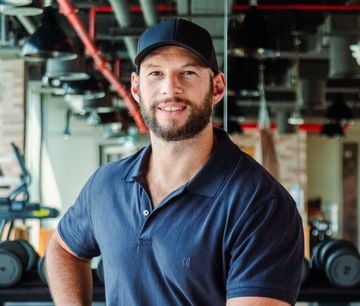Welcome to my review of the Joovv Solo 3.0. I've been a user of Joovv Red Light Therapy Panels for many years now and their first Joovv Solo is actually what brought me into the red light therapy space in 2017.
Since then, the red light therapy space has grown and developed tremendously. Joovv has grown too, and has been a great trendsetter for improvements in red light therapy panels.
In my 2019 red light therapy comparison series, for instance, the Joovv Solo 2.0 scored pretty poorly but was one of the highest power output panels out there back then.
Since then, I've reviewed a tremendous number of new red light therapy panels - all that data you can view in my red light therapy shopping Tool. My red light therapy buyer's guide is an excellent resource if you want to learn more about how I test panels.
But, back to the Joovv Solo. I had high expectations for this panel before reviewing it, as the Joovv Solo is always one of the most popular panels out there. You can view the Joovv Solo 3.0 below:
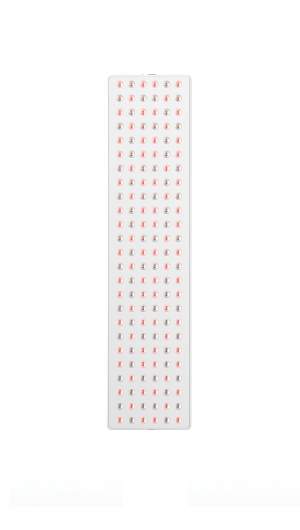
The Joovv Solo 3.0 got released in late 2020, so, it was time for me to put out a review! As of right now, it's 2024 and I'm slightly updating this blog post, and also publishing it on my new website here.
So here's my strategy for this review. Below, I'll first give you my review summary. Next up, you'll get a table of contents where I include all different sections of this review. Then, lastly, you'll be able to read the full review and the conclusion.
Also, if you wish to watch my YouTube video that this review is based on, check:
As for the review, here we go:
Joovv Solo 3.0 Review Summary:
Pros:
- Quite decent power output, that's up there with a few other panels. The power output of the Joovv Solo 3.0 has also massively improved since the previous generation.
- Great branding, which is reflected in the packaging, app, design of the panel, and much more.
- Using the panel is straightforward and easy and the control panel is very well-engineered.
- Joovv is once again very innovative because of adding many new features to the red light therapy experience.
- The modular support system as well as different stands are upgraded and are really great.
Cons:
- High price and low value by the metrics I use. You pay a much higher price per Watt and LED than with other panels from other companies.
- Higher EMF readings, especially in the electric fields' domain.
- No multi wave technology - only 660nm and 850nm light are emitted.
- Warranty is okay but not - you'd expect great warranty if you're paying a hefty price
- A hotpspot issue so the light is not distributed equally across the body as well as it could
- Noisey due to only 2 fans activated when the panel is running, which creates a pitch that is personally irritating to me.
- Some functionalities are only available through the Joovv app
Interested in learning more? Read more below:
Joovv Solo 3.0 Red Light Therapy Panel First Impressions & Unboxing
Welcome to my first impressions and unboxing section. Here I literally take you through my experience of the package arriving at my doorstep and me unboxing it and using the product for the first time.
If you'd rather watch a YouTube video of that process, check the video below:
If you'd rather read about my first impressions and unboxing experience, continue scrolling down. The first impressions video and blog both contain the same content, so don't worry about missing out on anything!
So, let's begin with the beginning:
Packaging First Impressions
Here you can see me with the Joovv Solo 3.0 package:
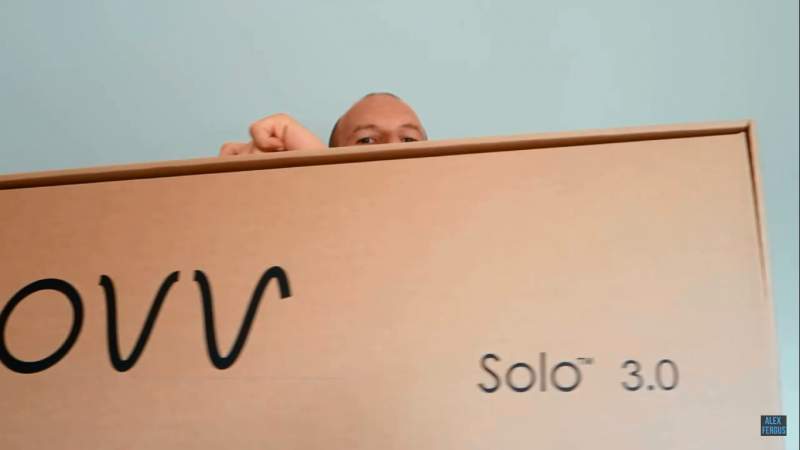
My first impression about that packaging is that it looks really amazing. You can very clearly see what is inside the package and who sent it to you.
Some other red light therapy brands send you a package with a red light therapy panel where there's no branding on the box. Sometimes you can only tell by the shipping label where it's coming from.
Next up, this picture shows you what to expect after opening the box:

There's also a stand included in the box:
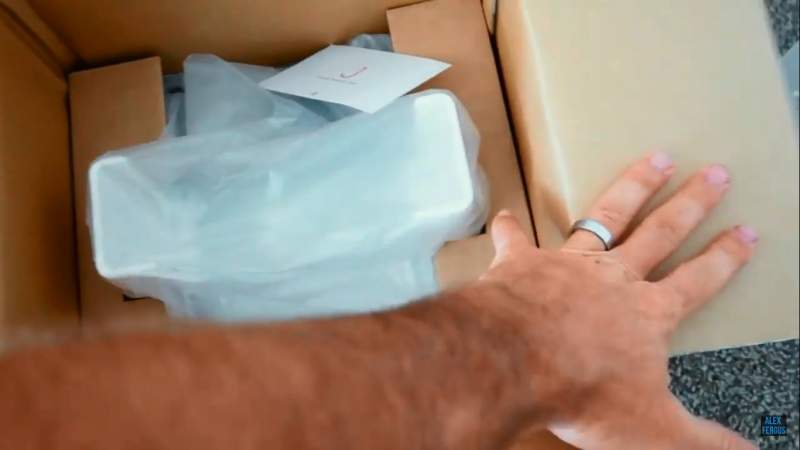
Unwrapped, the stand looks like this:
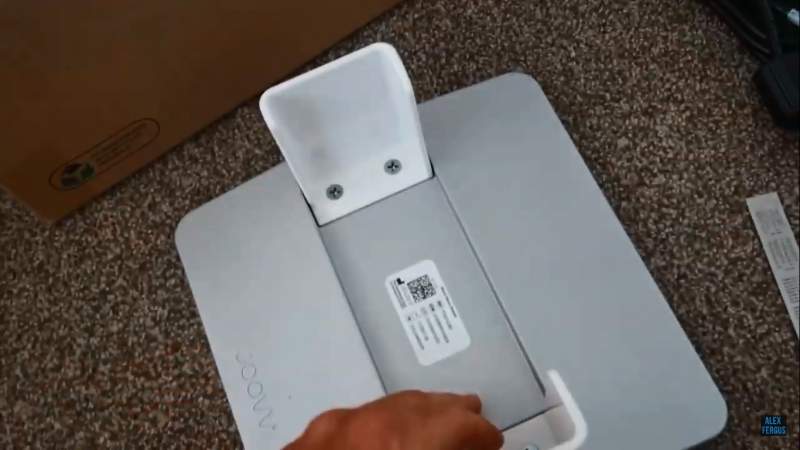
The stand is heavy-duty and metal-based, and will thus easily hold the plastic panel vertical. The benefit of this stand is that you can now place your panel everywhere in a room, not just hang it against the wall or a door. Huge props for Joovv here, once again!
I wish more companies would copy Joovv here, as once you've tried this, you don't want to be without it anymore!
So, here you can see how the panel looks into the vertical stand:

After using the floor panel, however, I do immediately notice a big downside. The panel is really close to the floor and if I'm standing up, it's impossible to treat my upper body unless I place the floor stand on another object.
You could stack 2 Joovv Solo 3.0 panels on top of each other on the floor stand though and gain the ability to treat your entire body though. You can also use the panel in the floor stand sitting down, and then later stand up to hit your legs with red light therapy.
But let's go back to my unboxing experience:
So far, the unboxing experience is the nicest I've experienced with any red light therapy panel so far. Joovv really thought deeply about how to improve this process and the professionalism really shines through because every single step has been optimized.
Keep in mind that I've unboxed dozens of panels over the years, so I've got some experience!
The entire packaging and unboxing process makes me think of Apple, which was one of the first to really perfect the packaging process with their iPhone.
The first thing I noticed after lifting up the panel is how light it weighs. This panel, contrary to any other panel on the market so far, has a plastic hull, drastically reducing its weight:
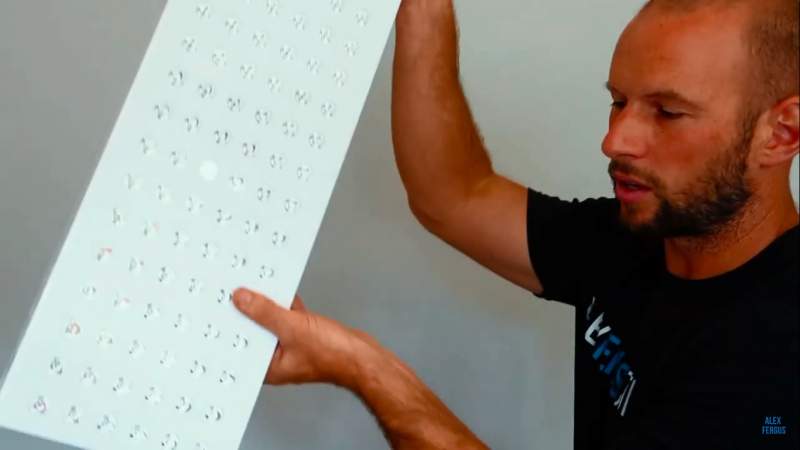
For me, personally, as I'm a healthy 30-ish male with a bodybuilding and strength training background, the weight is of no issue. However, if you're older or have health conditions, being able to move the panel around more easily is a huge plus. I'll come back to this topic later on in my first impressions section.
Let's consider the panel in more detail:
Size Of The Panel & LEDs
The size of the panel has a width of 9 inches and a height of 30 inches. The thickness is only a few inches and is less than many other panels out there.
This size of 9 by 30 inches is around average for what I call a "wall panel in 2024" (previously these panels were called "body panels)
(If you're not aware I created a 2024 red light therapy comparison series for body panels HERE).
The Solo 3.0 panel contains 150 LEDs in total. The wavelengths of these LEDs are 660 nanometers and 850 nanometers. This panel, therefore, doesn't contain the "multi-wavelength" technology that many other panels contain, which is a bit of a bummer.
I actually think that there are benefits to additional wavelengths such as 630 nanometers (nm) and 810 nm, 830 nm.
Of the 150 LEDs, 76 are found in the red part of the light spectrum, and 74 are in the near infrared light part. If you don't know what I'm talking about with terms as "red light" or "nanometers", then be sure to read my guide what is red light therapy.
Now, let's take a look at the back of the panel:
Handles At Back Of Red Light Therapy Panel
Here's where the real magic starts with the Joovv Solo panel - the back of the panel actually contains four grips (handles) in total, two of which are placed so that you can grip the panel vertically:
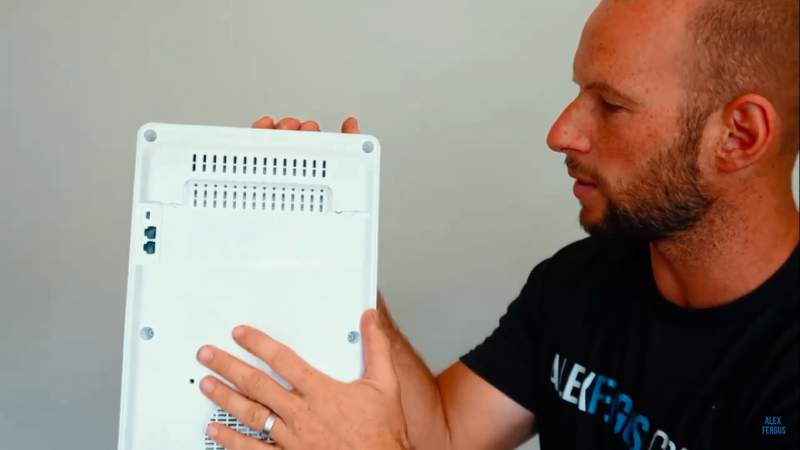
Naturally, the light weight of the panel combined with the grips make it much easier to move around.
The four handles that were added really impressed me and showed that Joovv completely overhauled their entire design from the bottom up with this panel.
Here, you can see the horizontal handles of the panel:
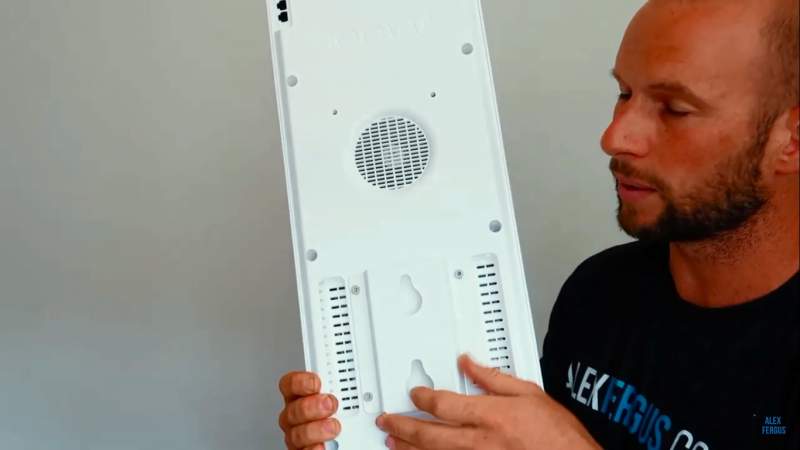
In between the two horizontal handles, you can see two plugs. The goal of the plugs is to be able to attach a panel to the wall.
Above the wall plugs and the handles, moreover, you can see the fans for cooling the panel. The Joovv Solo 3.0 contains two fans in total.
Then, at the bottom, the power plugs and ability to use the modular setup (multiple Solo or different Joovv panel) are located:
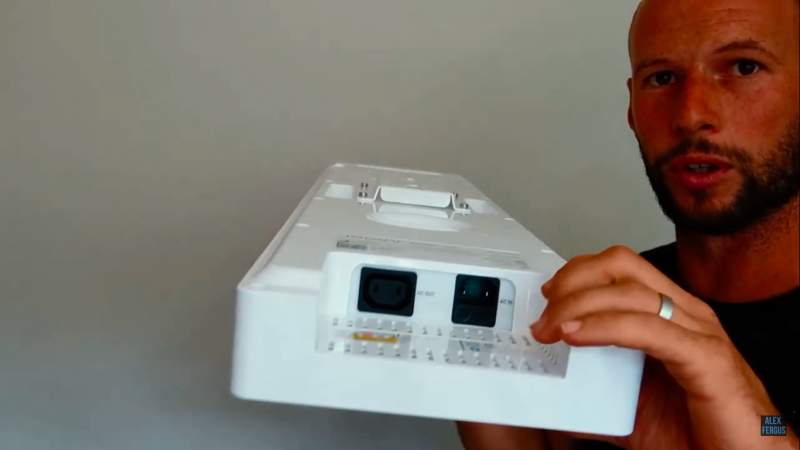
Instruction Manual
Inside the box there's also an instruction manual. The manual looks really sleek, as you tell by this picture:

The manual is 40-50 pages long. I didn't bother reading it because I've used so many panels but nevertheless, manuals are part of my scoring system in my 2024 red light therapy comparison series (this series was updated in 2024 - I've included the new link!)
Why care about instruction manuals? Simple: not every buyer is like me and has tested many panels. If you're a beginner in the red light therapy space then a solid manual will help you set the panel up and use it properly tremendously.
(Edit: after doing my full review I definitely see value in this manual. The advanced features such as the Bluetooth function and modular support are explained really well in this manual. There are some great schematics in the manual on how to best set up your modular support. for instance. Many additional topics are considered in the manual.)
Bonus points, thus, for the Joovv Solo in this regard!
Also, on the Joovv website you've got additional options to set your panel up. These options include the door mount and a mini stand.
Box Inclusions
In the box there are all the standard inclusions, but, Joovv has also gone the extra mile and added some extras that you don't receive with other red light therapy companies:
- A power cable - unfortunately I didn't receive one with a New Zealand plug, so that was a bit of a bummer. The cable is 9.5 foot long though, which lowers the risk you need an extension cable to reach the power socket on the wall.
- The very detailed instruction manual I just talked about
- The vertical floor stand which I've talked about before. This floor stand replaces the door hanging kit that's included with many panels. I personally think the vertical floor stand is a much better solution than the door hanging kit, as the kit never really worked for me because my doors are too thick.
- An instructions and setup card. This card is really small and contains Joovv's web address to find additional information.
- Protective gear (picture included below), specifically really nice eye goggles:
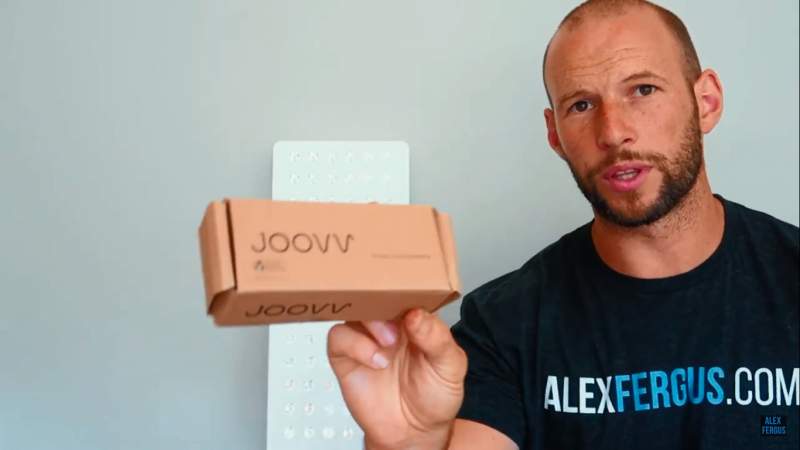
Inside that box you'll find the following protective glasses:
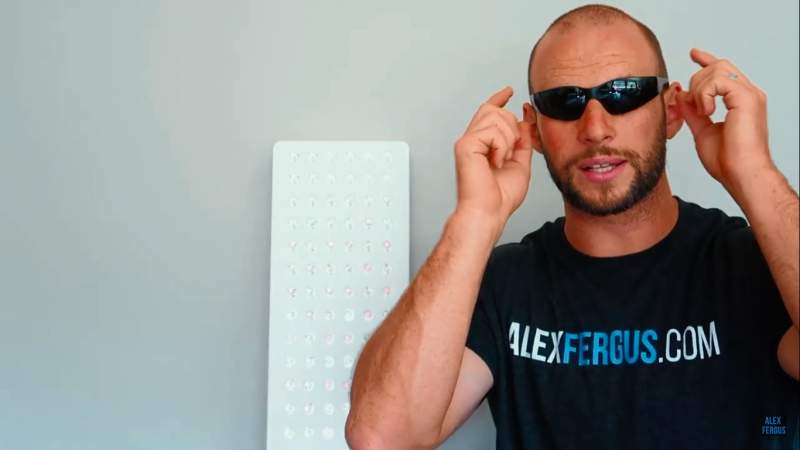
Now, the good thing about this eyewear is that it's specifically made for red light therapy. Other companies also send out eyewear but usually, that's simple goggles that are also used for other purposes.
Once again, Joovv has redesigned a part of the red light therapy experience from the bottom's up.
The good thing about these glasses is that I can actually see through them, unlike with the products of many other companies. The Joovv eye protection glasses are still dark though, but, the green world around you still allows you to see something at least!
On the box, Joovv has stated how much light penetrates these glasses. 93% of red light is blocked out, and 42% of near-infrared light. So, if you want to lower your exposure during a session while still being able to see, you could stand right in front of a panel and read a book, without oversupplying your eyes with light, for instance.
Next, let's reflect on some differences between the Joovv Solo 2.0 and 3.0:
Joovv Solo 2.0 And 3.0 Differences
Here are some differences between the older Joovv solo and the new one:
- The panel design is completely refreshed. Handles have been added and the panel is now made from plastic, instead of heavier materials. The panel is thus lighter. Also, the new 3.0 panel looks somewhat nicer too.
- The 3.0 panel supports Bluetooth with an app now. The app gives you access to certain functions that the control panel at the top of the panel doesn't give.
- The control panel is also updated and looks a lot nicer!
- The LEDs are higher-powered. Joovv claims there's a 10% increase in power output from the 2.0 to the 3.0. Joovv also claims there's a greater treatment area now, as they've redesigned the inner engineering of the panel so that the same power consumption results in increased light output.
- There are three different types of stands for the Joovv 3.0. The vertical floor stand you've seen, and the wall-mounting option. The wall mounting option costs around $60 extra. And, there's a door-hanging option.
- The Joovv 3.0 now has a recovery+ mode. This recovery+ mode entails that there's a pulsing feature now, at 10 Hz. You can learn more about pulsing in my video on the topic. Only the near-infrared light can be pulsed with the Joovv Solo 3.0. The pulsing frequency of 10 Hz cannot be changed like with the LightpathLED Large Multiwave Pulsed panel.
- A start-stop function, which ensures the light doesn't come on automatically. in other words, with the 3.0, the brightness slowly increases after you active the light. The start-stop function only works with the red light therapy.
- Then there's a session beeper, which can be used through the app. The session beeper allows you to get a beep after a certain time interval. For instance, you can program a beep halfway through your session as a reminder to turn around.
- An ambient mode, where you can use the Solo for background lighting at a low intensity. This addition is really nice I think!
Curious? Here's what I found out after testing this device:
Testing The 3.0 For The First Time
Let's continue my first impressions of this red light therapy panel. Here's what the panel looks like after I've activated it:
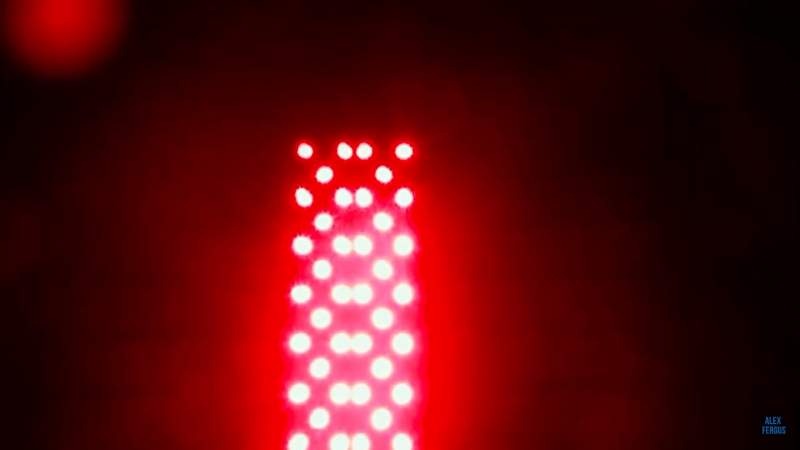
Again, the light comes on very slowly, which is a nice feature. The timer on the control panel also only starts running after full brightness has been achieved.
Also, one thing I noticed was an irritating sound. The sound is not necessarily louder than other panels I've tried but still very noticeable to me.
(I've later discussed this issue in my 2024 red light therapy comparison series episode on sound & flicker, specifically regarding this panel!)
Next up, the control panel at the side really looks good:
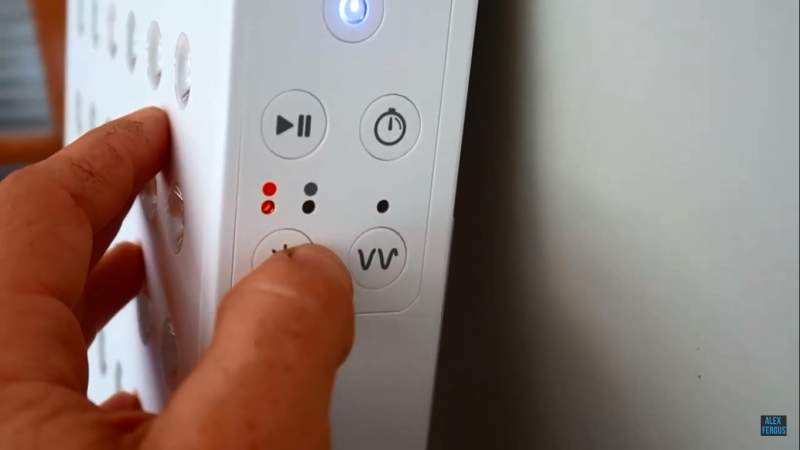
The button I'm pressing is for the red and infrared activation and/or deactivation. The button on the bottom right is to active the 10 Hz pulsing option for the near infrared only. The button on the top-right is to start or pause the light, and the top right is for setting the timer.
Easy peasy!
Next up, let's explore the Joovv app:
Joovv App
The Joovv app is used to access some of the functions of the Joovv. You cannot use functions such as the ambient light without the app, from the control panel, which is a bit of a bummer to me.
Here you can see me use the Joovv app:

To connect a device, you need to hold the bottom two buttons on the control panel and the wireless function is activated.
Next up, after pairing the app and the panel, you'll end up with the option to control your panel from the app:
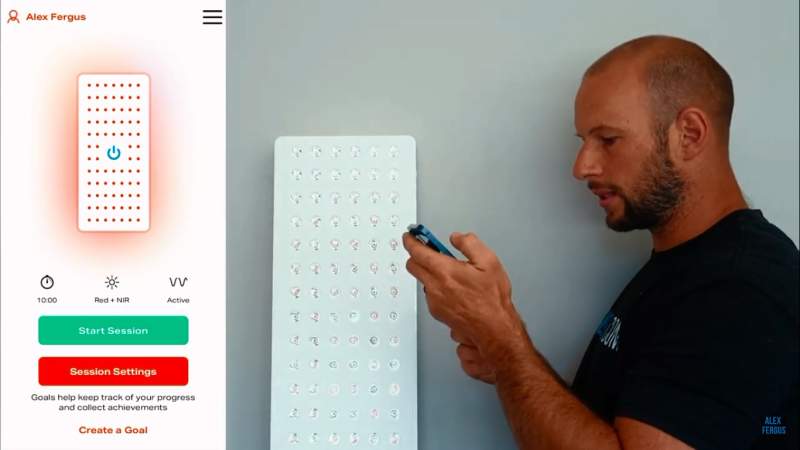
After clicking "session settings", you'll end up with the following options:
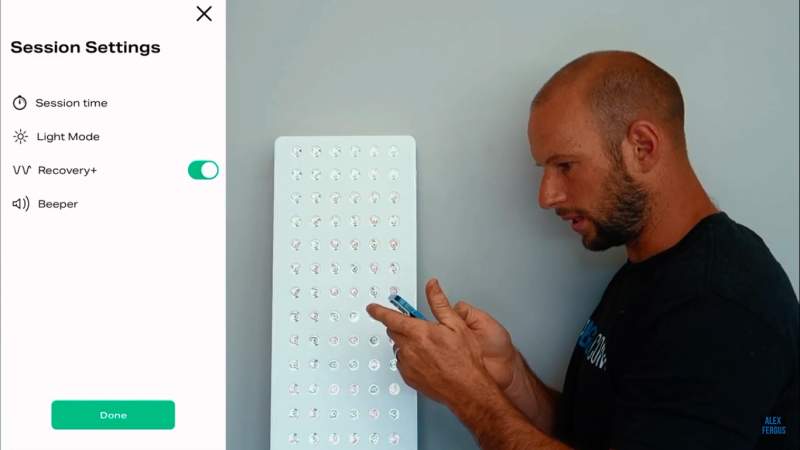
As you can see, here you've got the option to use the timer ("session time"), red or infrared light ("light mode"), the pulsing option ("recovery mode"), and the beep function.
The beeper can be set up for "beep 2 minutes before the end", "beep at mid" session, "beep every 2 min", and "beep at end".
In "light mode", you can also activate ambient mode, to use the Solo 3.0 for background lighting. Ambient mode can be used at 100%, 75%, 50%, and 25% of maximum light output intensity.
The downside is that you cannot use the ambient mode for a very long time, as there's still a timer function. I'd prefer an indefinite option. Also, the fans are running at full speed even at 25% of power output.
But, you might think, what is all of this going to cost me? Here's the price:
Price, Shipping, Warranty & Discount Code?
The price of a Joovv 3.0, at the moment of shooting the YouTube video, is $1,345 USD. At the time of converting these videos into a blog post, the price has increased to $1,445 USD.
The panel has a 2-year warranty. This warranty is "okay" but not great. There are companies offering a 5-year warranty right now, like for the Red Light Rising Advantage 900 and 1500 (in 2024, that panel is no longer on the market - the company is releasing a new option soon!)
Also, there's a 60-day return period where you can ship the panel back at your own cost and get part of your money back. I say "part" because there's a restocking fee for sending a panel back.
Joovv does have a great support team that can help you because they're such a big company. In general, the support of Joovv is considered top-notch!
Also, depending on where you're located in the world, shipping and taxes are also added to your bill.
For instance, if I use addresses in New York City or in California, I pay about $120 extra above and beyond the normal price point in taxes.
Shipping costs about $90 USD for the USA, $260 for Australia, $160 for the United Kingdom, and $130 for Canada. Local taxes are not included here, but Joovv has a very neat calculator in their checkout screen that allows you to estimate import and customs duties.
Also, I don't have a discount code for Joovv. The reason is that Joovv runs an exclusivity affiliate program, meaning that, if you're affiliated with Joovv, you cannot be affiliated with any other red light therapy company. And, if you're affiliated with another non-Joovv red light therapy company, you cannot be affiliated with Joovv.
Well, personally I'm affiliated with any red light therapy company I can, just to remove the bias from my reviews. Unfortunately, that choice means I cannot be affiliated with Joovv and give you a discount code for their panels.
And, that's my first impression and unboxing experience. Next up, I'll move to my full review which took a few months to complete. First up, my quick review, which is a summary of my findings:
Joovv Solo 3.0 Quick Review
Here's a video I shot after using the Joovv Solo very intensively for a few weeks:
This quick review only summarizes and takes the most important findings from my full review. The quick review is about 5 minutes long while my full review is 50-60 minutes long. So, if you want to know all the details, check the latter. If you're time poor or just want the most important info, check the quick review.
The full review contains all the same content as the quick review so I'm not writing down my quick review in the blog post here. Read below to learn more:
Joovv Solo 3.0 Full Review: My In-Depth Experience And Testing After Months Of Use
So, welcome to my full review of the Joovv Solo 3.0! I've reviewed this panel in the YouTube video below, so if you prefer a video version of my content, check it out:
Also, in my written blog review I've left out any repetitive information from the quick review so that I don't give you the same information twice.
Design: Looks & Feel
Even after these many months, I'm still impressed with Joovv in this area. Of course, you're paying a premium price, but that higher prices do translate into a much better unboxing experience and a panel that's designed really well.
You'll get premium labelling, premium accessories, etcetera.
With 150 LEDs, also, the panel is on the smaller size for a "wall panel" classification, which has up to 300 LEDs for me. Then, it's not that 150 LEDs is bad per se, it's just that panels from the competition have just gotten much bigger over the last few years.
Also, in my first impressions video, I noticed how light the panel is. I weighed the panel and it's 14 pounds, which translates into 6.3 kilograms. Only the mounting bracket is made from metal, the rest is made from plastic.
Joovv has changed their entire supply chain for this renewed engineering and look, as their panel is now shipped from Malaysia, not China. Joovv is the first company to make this change.
Also, the new panel doesn't have any hooks on top of the panel to suspend it from a wall, contrary to other panels on the market. Contrary to other panels, there are also no air vents on the side of the panel, which looks pretty neat.
After all of these 6+ months of using the Joovv Solo 3.0, I'm also still very much impressed with the four handles/grips on the top, bottom, and in the middle. I think the handles are such a great addition that I hope that all panels will have them in the future.
Next up, besides the low power plug on the panel, Joovv has also supplied you with a 9.5-feet cable. The benefit of both changes is that you don't need an extension cable as quickly to reach the power socket.
Let's now move on to my actual testing:
Wavelength Testing
For my wavelength testing, I use the Hopoo Color 0HSP-350F - 380-1050nm Spectrometer. Here's the outcome in the red light part of the spectrum:
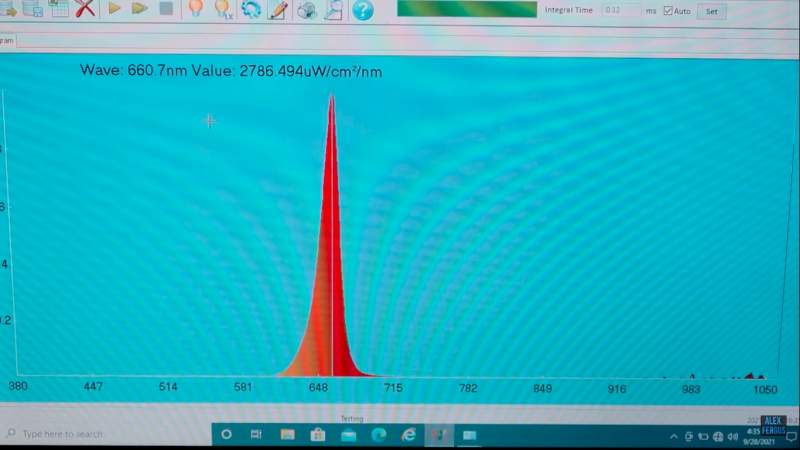
The 660.7nm only differs 0.7nm from the marketing claim, which is truly awesome. A 5 point plus or minus difference I still consider decent.
The only turnoff is that there's only one wavelength emitted and not multiple per part of the light spectrum. You can check out how many other panels do in this regard - called "multiwave" - in my blog post about different wavelengths for the best red light therapy with regard to wall panels.
Then, there's the near-infrared measurement:
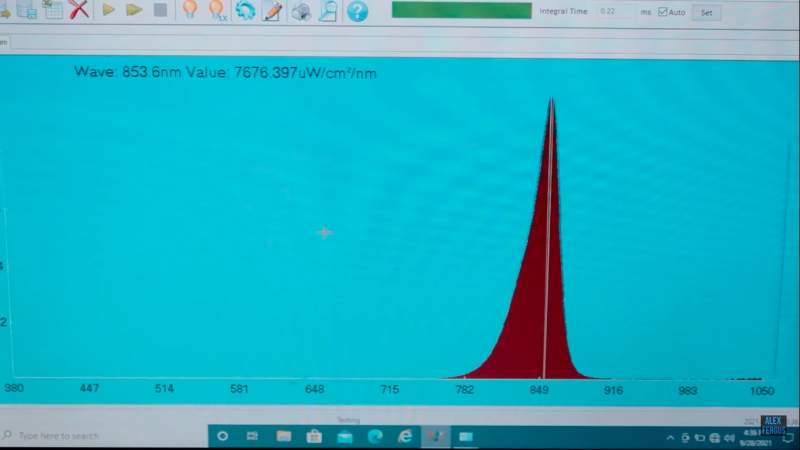
Here there's a 3.6nm difference from the claimed 850nm, which is very good once again.
I've confirmed these outcomes with different measurements, and all outcomes ranged across the outcome I just had.
Let's move on to the next spectrometer measurement:
Power Output (Irradiance)
Power output is simply the amount of light panel is putting out. Below you can see me measuring the power output with my spectrometer:

Here's the power output readings I got:
- Peak power output: 72.4 mW/cm2 - that outcome is really great and much higher than what I got off the Joovv Solo 2.0 in 2019, at 48 mW/cm2. Joovv has thus massively improved its overall power output. The only caveat here is that there's a big difference between the peak power output and the average readings I got across the panel. Most of my readings were around the high 50s.
- Red light only power output: 45.2 mW/cm2. If you want to know how these numbers compare to the competition, check out my red light therapy Shopping Tool.
- Near infrared light only power output: 66.3 mW/cm2. Here I've deactivated the red light. Outcome speaks for itself!
- Average power over 9 spots: 59.2 mW/cm2. That outcome is quite good. With this test, I use 3 spots at the top of the panel, 3 in the middle, and 3 at the bottom. The spots are left, right, and center of each of these locations. The previous Joovv Solo 2.0 only had an outcome of 39 mW/cm2, so Joovv has massively improved the power output of this panel! Higher readings here imply that the peak power at different locations is higher for the panel overall- there's not just a lot of power at one spot.
- Total power output: 84.9W. Here I calculate the total light output, by taking the average power over 9 spots and using the size of the panel's LED area to come up with a total power output. The previous Joovv Solo 2.0 had a 58.6W outcome, so once again, there's a massive improvement here! To put this number in perspective, the MitoPRO 1500 which has double the number of LEDs has 136W (code ALEX5 saves). The power of the Solo 3.0 is really good though!
If you want to learn more about these measurements, consider my red light therapy buyers guide - there I explain all the measurements I take.
Next up, I tested the wattage draw, the amount of electricity a panel takes from the electric grid:
- Total wattage draw: 390W. Here both the red light and near infrared light are activated.
- Red light only wattage draw: 213W.
- Near infrared only wattage draw: 196W.
A higher wattage draw usually implies higher power output, although some power is also diverted to the control panel, the fans, etcetera.
Moving on to the hotspot testing now:
Hotspot Testing
With the hotspot testing, I observe whether a panel distributes the power output evenly or not. If there are patches where the color really changes then there's an indication that the light is not distributed equally.
For instance, you might have a patch of red light and then a large invisible area (where near infrared light is emitted), meaning that exposure is uneven.
Here's the outcome I got with this panel:
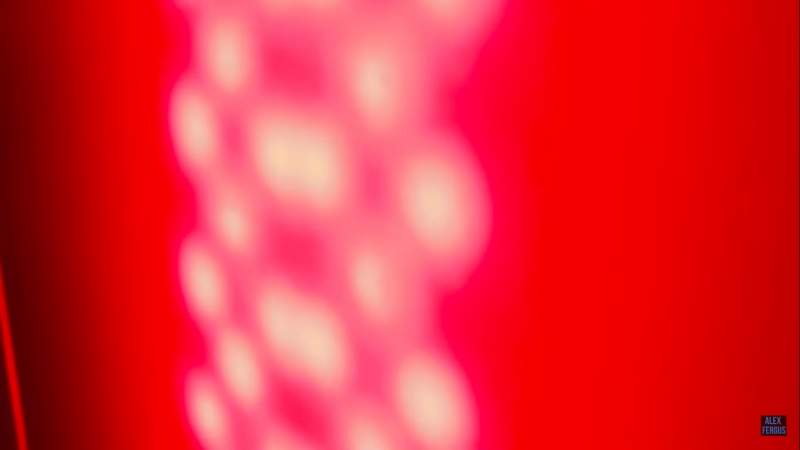
This hotspot outcome is quite bad, as the light is spread really unevenly across the output. Check the visual representation of this testing in my YouTube video HERE.
Value Calculations
Here I calculate how much bang for your buck you're getting. I have two measurements here:
- USD per LED: $9.10 per LED. That figure is up there, and ideally, you'll want to be under $5. This panel is quite expensive. The price has actually gone up since the Joovv Solo 2.0
- USD per Total Wattage: $16.10. That number is quite high too. The number has come down a bit from the previous generation though! Still, some companies offer great quality panels under $10 per Total Wattage
Conclusion? You're spending more money for a lower-powered panel. You can compare these numbers to competitors on my red light therapy Shopping Tool.
EMF Testing (Radio Waves, Magnetic Fields, Electric Fields)
In this section I test the EMF levels with the Cornet EMF meter. I was quite curious about this testing because the power plug doesn't isn't grounded. If my theory is right, the electric readings won't be great.
My finding? The electric readings were indeed not great! Here's are the outcomes:
- Electric fields: 23 V/m at 6 inches. At 3 inches that number jumped up to 90V/m. The six-inch reading was still in the green zone (safe) of my EMF meter that's configured according to the building biology standards. The three-inch reading is in the orange cautious zone. Right on the surface, this panel is unsafe for use! If there was a power plug with a grounding point these numbers would immediately be lower!
- Magnetic fields: at three inches, the outcome is 1.08 microTesla. At six inches, it's 1.5 microTesla, which is just up in the yellow zone. You're thus getting some magnetic field exposure at both 3 and 6-inch distances! Ti's best to use this Joovv from 6 inches and farther away.
- Radio waves: numbers are absent unless you turn on the Bluetooth, where exposure is expected. Please know you can use the panel with Bluetooth deactivated!
Overall, the outcome is not too great here! Moving on to the next round:
Flicker & Sound
Flicker was really simple, both readings were 0. So, that outcome is very good but also expected for panels in 2021.
Sound exposure came out at 62.1 dB. That number is quite high if you compare it to other options in my Excel sheet where I give you data on every panel and other product I've tested so far.
Not only is the sound loud, at 62 dB - which is 10-fold or more higher than some of the other 50dB readings - the pitch also irritates me.
The fans are producing a very irritating pitch, probably because there are only 2 fans. If you stand next to a panel during a session it does irritate me. Consider this part of my full review video to hear that pitch.
Control Panel Operations
After I've used the Joovv Solo 3.0 for quite a while now, I've learned a lot more about operating the panel. Here you can see the control panel after I've activated it:

Here's what I noticed using the control panel:
- After you put the power plug into the wall, the unit will immediately activate. There's no power switch at the back you have to activate for the panel to get power.
- The power button at top emits blue light, unfortunately. That blue light is noticeable at night, and I'd rather have seen the light emitted to be red. If you don't know why blue light can be harmful, read my article about why blue light can ruin your sleep and makes you fat.
- By default, the red light and near infrared light are both activated, as you can see in the bottom-left corner.
- The timer button on the top-right changes the timer with 1 minute at a time, all the way up to 20 minutes.
- After using the panel for some time, the light slowly coming on is great. During this time the brightness increases, the timer does not start yet. I really love that you're not hit with full intensity after activating your unit.
- What I don't like is that when you turn the panel off, the light also slowly turns off. For going back down, if someone walks in the room, you just want to turn it off. For that reason, I've just started using the power button.
Let's now explore what I found regarding the app after using the panel for many months:
Joovv App After 6 Months Of Use
As I've stated before, some of the features you can only use on the app. I wish the control panel could give me access to all features but with the Joovv Solo 3.0 it doesn't - hope generation 4 does better here!
Here's what I found regarding the app:
- I wish ambient mode could go down to 10% or 5%, or even 2% power output. The current lowest option of 25% is still quite bright and much brighter than any other lights in the room you're probably using. With the PlatinumLED BioMax, for instance, you can slide the power down right to 1%.
- Also, at 25% ambient light, you're still running the fans, which give you the irritating pitch exposure
- I've also learned that once you've enabled ambient mode, you can set the timer right up to 90 minutes. I think those timers are there to protect the interals of the panel from overheating, which is why you can probably not exceed the 90-minute threshold
- You can sync multiple panels in the app
- The app can track your sessions and progress and you can even plan how many sessions you want to do each week. I personally don't use that option. You have to sync your sessions through the app to track them, so if you're just using the panel with the power button on the control panel without syncing, the sessions are not logged in the app.
- I've also had some problems logging into the app at times and that fact has driven me nuts.
- Overall, I don't think you need an app to use red light therapy. This is red light therapy and a few simple controls should be able to give you a productive session. Companies will come up with novel ideas to outcompete other companies though.
With that being said, let's move on to the next section of the review:
My Personal Experience With Pulsing
Overall, just like many of the panels I've reviewed, the most important thing to remember is that the Joovv Solo 3.0 panel just works. Here's what I found about this Joovv panel though;
I can't tell whether the pulsing function is working, even though I've tested it extensively. I had the same experience with the LightpathLED Large Multiwave Pulsed. I will also say that I haven't been training hard or having an opportunity to really test this pulsing option. And, to be honest, I'm not sure whether anyone would really notice the pulsing unless you did a proper study on it.
Joovv Solo 3.0 Versus Other Offerings
Joovv offers more products than the Solo 3.0. For instance, they offer the handheld Joovv Go 2.0, which I've included in my 2021 handheld red light therapy review.
The company also offers the Joovv Mini 3.0, which is half the size and costs $895 USD. The Mini has the same features as the Solo 3.0 though, but does come down to nearly $15 per LED. Even with the expensive Solo 3, you're getting a much better bang for your buck, as the Mini is around 60% more expensive!
Here you can view the Joovv Mini 3.0:
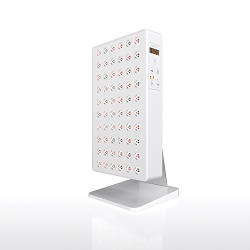
The next step up from the Solo 3.0 is the Duo 3.0:
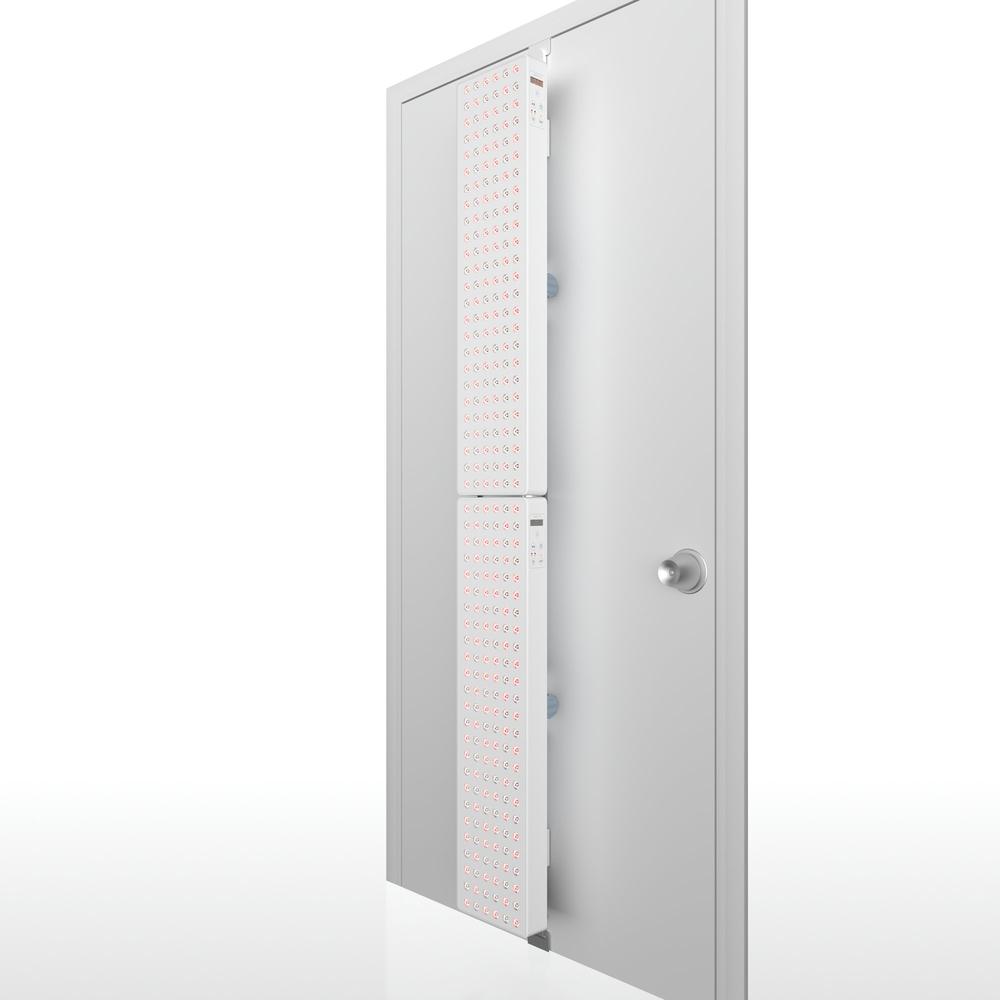
The Duo 3.0 is simply two Solos stacked on top of each other and costs $2,895 at this time of writing.
You'll also receive a door mount with that product.
These Solo 3.0 panels can be combined into a Joovv Max 3.0, with 2 Joovv Solos and 2 Joovv minis, all the way up to the Joovv Elite 3.0, which looks like this:
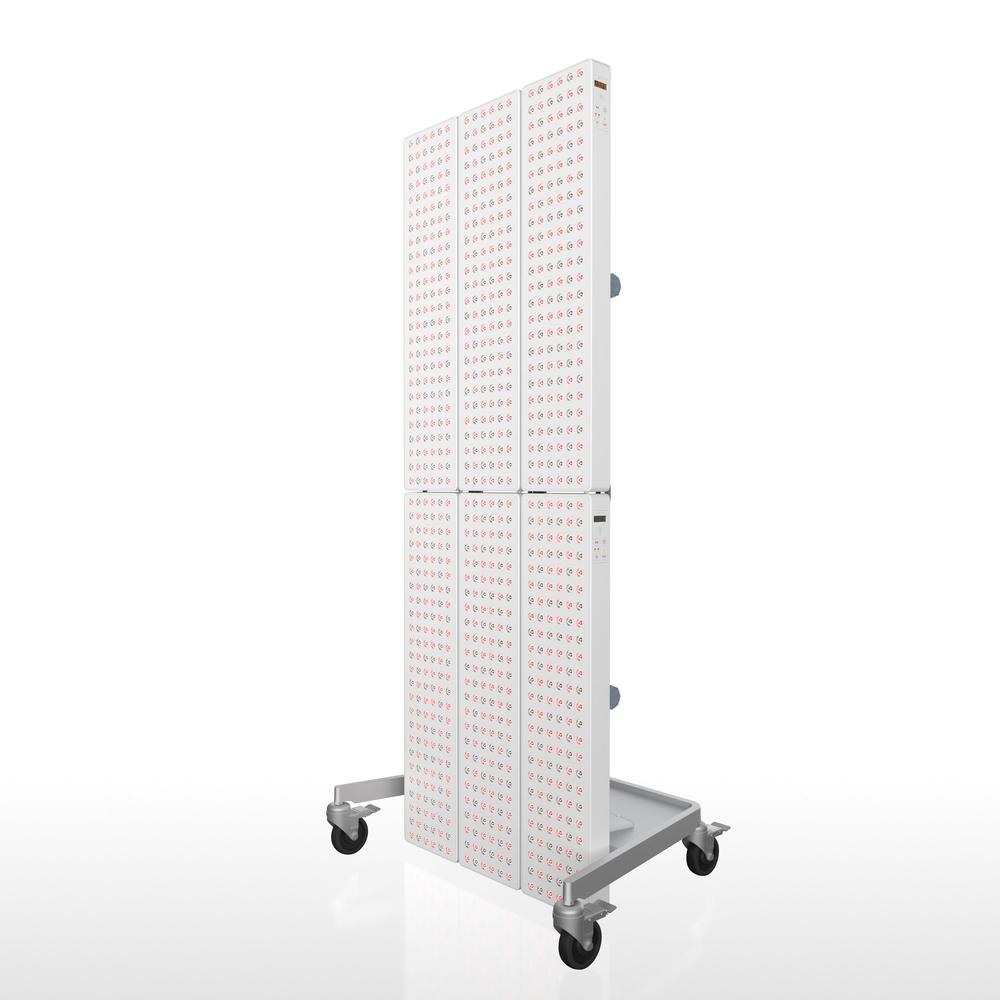
The Joovv Elite costs $8,570 (as of 2021 - in 2024 the prices have probably increased!). However, you can just buy the Joovv Solo 3.0 and build your way up from there, as there was no discount for buying multiple as of the time of me shooting these YouTube videos.
Overall, I hope the panels above give you a good impression of the new 3.0 Joovv product line!
Next up, the following logical question can be asked:
Comparing The Joovv Solo 3.0 To The Competition
We know red light therapy works, the question is only what panel works best for your personal requirements. I've said it over and over again, many of these panels out there from the prestigious companies that have been around for a while simply work.
Nevertheless, let's compared the Joovv Solo 3.0 to some other offerings on the market:
- Joovv Solo 3.0 versus PlatinumLED BioMax 600. The Solo 3.0 has 150 LEDs to the 200 LEDs for the BioMax 600. With the BioMax 600 you're also getting multiwave technology, with 5 different wavelengths to be exact. The BioMax has a 3-year warranty, and costs $899 - that's a $500 saving.
- Joovv Solo 3.0 versus Mito Red MitoPRO 1500. The MitoPRO 1500 has 300 LEDs, 4 wavelengths from multiwave, and sells for $1,100 USD. So, the MitoPRO 1500 is still far cheaper, has better EMF readings, and has more power output too.
- Then, there's LightpathLED Large Multiwave Pulsed versus Joovv Solo 3.0. This comparison is great if you want pulsing technology. That LightpathLED panel costs under $1,300, has pulsing options manually configurable from 1Hz-9,999 Hz and also special inbuilt Nogier frequencies. The Large Multiwave Pulsed has 225 LEDs, versus 150 in the Joovv Solo 3.0, emits 5 wavelengths (multiwave), so, you'll have to consider these alternatives here.
If you're having trouble making a decision, I completely understand, and I highly recommend watching my 2024 red light therapy body comparison series on YouTube or the best red light therapy panel on my blog.
If you want my latest recommendations for wall panels, check my best red light therapy panel video or the extended cut of the best red light therapy panel comparison!
Lastly, let's move to my concluding thoughts:
Concluding Thoughts: Likes And Dislikes
Here's my final assessment with some simple likes and dislikes about this red light therapy panel:
Likes:
- The design of the Joovv Solo 3.0 is really great. The design is new, fresh, and different. The panel is light too and is made of plastic but that's just surprising. The handles on the back and sides are really great. I've probably just got a little bored seeing the same panel over and over again after testing dozens of them from different companies, and Joovv really did a great job here engineering a unit from the bottom up!
- The modular support system is upgraded and really great. With the bracket at the back of the panel you can now attach the panel to a wall stand or door stand, and, there's no longer the metal modular support connection on top of the panel.
- The power output is decent. Yes, you've got panels out there that have far higher power output, but still, Joovv massively upgraded the power output from this panel compared to the previous generation. And, many other companies have panels with a much lower power output too.
- The new features and functionalities that Joovv has incorporated are really great. The low power option for ambient lighting is great, for instance, as well as the beep halfway through a session, and also the slowly increasing brightness after you start the panel. These improvements are just little things but incrementally over time they will be a game-changer in the industry if Joovv keeps innovating.
Dislikes:
- Many of the new functionalities are only available through the app. I'd rather have these options at my disposal from the control panel. I tremendously dislike having to set up an account and syncing. Buttons could be added to the control panel for these options. Joovv could alos use an LCD screen like the BioMax does.
- Hotspots have gotten worse actually from the generation two panel to this one. This is a bit of a backward step, unfortunately.
- Then, there are only two wavelengths emitted by the panel. I know Joovv doesn't believe in multiwave technology like other companies do but I find the science on wavelengths such as 630 and 810nm very convincing myself. I personally think that Joovv will lose a lot of customers who want more wavelengths than just the basics
- The EMF levels are high, especially in the electric fields area. This is a bummer because it can easily be prevented with proper engineering. Back in 2019 these EMF levels would have been great but we're in 2021 now and many other panels expose your body to much higher levels.
- Then, therés the sound issues. Not only is the Joovv Solo 3.0 one of the loudest panels I've tested, it also emits a very bad pitch from the cooling fans. The more I used the panel, the more irritating it got for me.
- Next up, the warranty is just okay. In 2019 the two-year warranty would have been the norm, but now, in 2021, many companies offer a 3-year warranty, and up to 5-year warranty as with the Red Light Rising Advantage 900 and 1500. Especially given that the Solo 3.0 is the ultra-premium highest priced panel on the market, I'd have expected better warranty.
- Lastly, the panel is just overpriced. Yes, you can justify paying a premium for the app, the design, and the nice unboxing experience. But, in many of the basic features like EMF, power output, number of LEDs the Joovv Solo 3.0 doesn't shine. You can spend less money and get a panel twice the size with more power output, more wavelengths, less EMF, etcetera, so you really have to think about whether the app and pulsing feature and design are worth it for you. And yes, if you're really into the marketing and love the fact that your favorite athlete or sport's team uses Joovv, by all means, go for it! And, not only do you pay the price of the panel, the shipping costs are also higher than many other companies, as some offer free worldwide shipping.
At the end of the day, the value proposition of the Joovv Solo 3.0 is not great for me. Let's conclude and take a 30,000-foot overview:
Finishing Thoughts: Asking Yourself The Difficult Question
To me, only a few people should really consider the Joovv Solo 3.0 without exploring many of the other options on the market.
That situation is only the case if you really like some of the novel options Joovv has integrated into their product such as the app and the vertical stand and the grips.
Alternatively, you might really want a Joovv Solo 3.0 because of the marketing and the many celebrities using the product.
Both are good reasons if they're important to you. But, if you care more about power output, value, EMF readings, hotspots, or sound, then I'd at least explore a few other options before buying a Joovv Solo 3.0.
Update: Comparing The Joovv Solo 3.0 To The PlatinumLED BioMax 900
I've just made a YouTube video in which I compare the Joovv Solo 3.0 to the PlatinumLED BioMax 900:
Update: The Joovv Solo Mini 3.0 Review In 2023 And 2024
I also posted a video review of the Joovv Solo Mini 3.0 here:
Items Mentioned
- Hopoo Color 0HSP-350F - 380-1050nm Spectrometer
- Cornet EMF meter
- LightPathLED Large Multiwave Pulse - discount code ALEX saves
- PlatinumLED BioMax 900 - the discount code that you get after clicking the link saves 5%
- MitoRed MitoPro 1500 - The discount will automatically apply at checkout if you use that link.
- Joovv Solo 3.0 - no discount code available
Found This Post on Red Light Therapy Interesting? Then You Might Like:
- Red Light Therapy Resource & Discounts Page
- 36 Powerful Red Light Therapy Benefits
- Red Light Therapy Wavelengths Benefits: The Ultimate Guide
- Revealed – The Ultimate Red Light Therapy Panel Shopping Tool
- The Best Red Light Therapy Body Panel For 2024
- Red Light Therapy Pulsing: Worthless Or Useful? A Science Breakdown
This blog post was written by Alex Fergus. Alex is a ISSN Sports Nutrition Specialist, Fitness Professional and certified Superhuman Coach who continues to expand his knowledge base and help people across the world with their health and wellness. Alex is recognized as the National Record Holder in Powerlifting and Indoor Rowing and has earned the title of the Australian National Natural Bodybuilding Champion. Having worked as a health coach and personal trainer for over a decade, Alex now researches all things health and wellness and shares his findings on this blog. Learn more about Alex's Credentials HERE.
